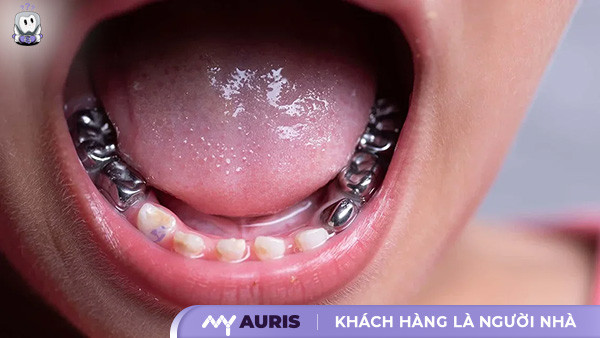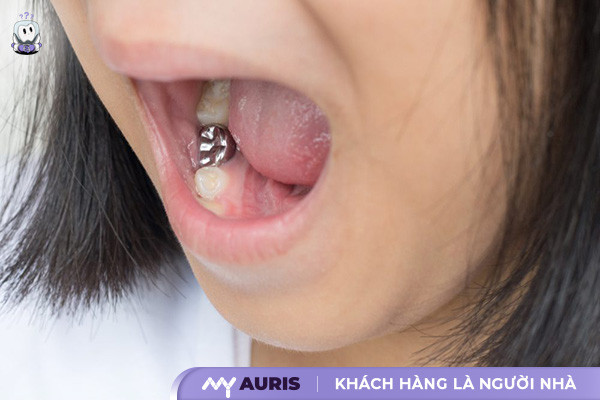Compared to adults, children’s teeth are more susceptible to decay due to thinner enamel and dentin structures, lower mineralization levels, coupled with limited oral hygiene capabilities. Furthermore, young children’s awareness of dental care is often inadequate, increasing the risk of rapid and severe tooth decay progression. Proper early prevention and treatment of tooth decay are key factors in protecting a child’s oral health right from the early stages of life.
What are Stainless Steel Crowns?
In pediatric dentistry, stainless-steel crowns (SSCs) are a widely used solution for dental restoration in children. These are pre-fabricated crowns, manufactured for molar teeth in various sizes, suitable for restoring both primary molars and permanent molars in children. This method stands out due to its high durability, good aesthetics, excellent finish, and convenience in treatment. It facilitates easy chewing, simple oral hygiene, and, importantly, provides comfort for the child throughout its use.
Tooth damage in children due to decay is a common condition, progressing faster and more severely than in adults. The main reasons are thinner enamel, thinner dentin, lower tooth mineralization, coupled with poorer hygiene habits and less awareness compared to adults. When not cared for or controlled, tooth decay in children can lead to severe consequences, affecting eating, aesthetics, daily activities, and even the child’s overall development.
For simple tooth decay, many parents often choose traditional dental fillings. However, due to the difficulty in controlling decay, situations with multiple decayed teeth, decay on multiple tooth surfaces, or the reconstruction of tooth morphology after root canal treatment are all challenging issues in treating tooth decay in children. Additionally, conditions such as enamel hypoplasia and bruxism are also concerns that parents should be aware of early on.
Among the methods for dental restoration in children, stainless steel crowns (SSCs) offer superior effectiveness. They not only help restore primary and permanent teeth but also protect them from further decay, while ensuring long-term chewing function and aesthetics. Thanks to the advantages mentioned, stainless steel crowns are increasingly considered a top choice in treating pediatric tooth decay at reputable children’s dental clinics.

Should Primary Teeth Be Crowned in Children?
Porcelain crowns are a solution often applied to improve decayed teeth, teeth with damaged pulp, cervical abrasion, or antibiotic-stained teeth in adults. However, whether primary teeth should be crowned in children is a concern for many parents. According to dental specialists, primary teeth should not be crowned with porcelain, as this can bring more harm than benefit.
In reality, primary teeth are replaced by permanent teeth as children reach adulthood. Intervention with porcelain crowns during the primary dentition stage is not only unnecessary but can also affect the permanent teeth later on. Some potential harms of porcelain crowns for children, as warned by dentists, include:
- Causes fear and anxiety in children: The process of tooth preparation for porcelain crowns can be painful for children and lead to a fear of dental clinics, affecting long-term oral care.
- Hindrance to tooth eruption: While jawbones are still developing, porcelain crowns can impede the natural development of a child’s teeth, making the transition from primary to permanent teeth difficult.
- Porcelain crowns become tight over time: Because porcelain crowns have a fixed size, while permanent teeth develop further as a child grows, they can easily become tight as the child grows, affecting the crown and potentially even negatively impacting the permanent tooth underneath.
How to Care for a Child After Receiving Stainless Steel Crowns
Post-Treatment Care
After the stainless steel crown is cemented, parents should ensure the child avoids chewing for the first hour to allow the material to set. For the first 1-2 days, it’s advisable to give the child soft foods to help them get used to the new sensation in their mouth. The child might experience some discomfort initially, but after a few days, they will eat better and regain their normal appetite.
Daily Care and Hygiene
Post-crown care plays a crucial role in treatment effectiveness. Parents should teach their child to brush normally, combining proper cleaning of both their teeth and the stainless steel crown. Use dental floss to remove food particles stuck between teeth and the crown, ensuring thorough cleaning. At the same time, it’s important to limit hard and sticky foods like hard candies and chewy candies, as they can quickly cause tooth decay and even dislodge the crown.

Monitoring and Follow-up Appointments
Parents should take their child for regular follow-up appointments every 3-6 months, according to the dentist’s schedule, to check the crown’s adhesion and condition. If there are signs of a loose or dislodged crown, immediate dental attention is required. Stainless steel crowns are only used to restore the crown of primary teeth and do not affect the eruption process of permanent teeth. When it’s time for the tooth to be replaced, the stainless steel crown will come off with the primary tooth, making way for the permanent tooth to erupt normally.
Frequently Asked Questions About Stainless Steel Crowns for Primary Teeth in Children
Will a Child Be Uncomfortable When Eating After Receiving a Primary Stainless Steel Crown?
Receiving a stainless steel crown on a primary tooth may cause a child discomfort when eating for the first few days. This is a normal reaction as the body adjusts to the new crown. Some symptoms the child might experience include:
- A feeling of bulkiness or interference when chewing, leading to slower chewing; the child might not want to eat hard foods.
- The stainless steel crown may alter tongue and lip positions, causing the child to have difficulty pronouncing words, lisp, or speak unclearly initially.
However, these symptoms will gradually subside as the child gets used to the crown. The dentist will provide specific instructions on how to care for the child to minimize discomfort when eating after the crown placement.

Can a Primary Tooth Still Decay After Receiving a Stainless Steel Crown?
Although stainless steel crowns for primary teeth protect the tooth, restore its shape, and maintain chewing function, helping to prevent oral diseases, they are not the ultimate solution to prevent tooth decay.
Parents need to pay attention to oral hygiene, specifically:
- Brush teeth correctly and clean the stainless steel crown properly after meals.
- Use dental floss to clean between teeth and around the crown to remove plaque and food debris.
- Take your child for check-ups every 3 months to detect oral health issues early and treat them if necessary.
Maintaining good oral hygiene habits is key to preventing tooth decay after receiving a stainless steel crown.
Can Stainless Steel Crowns for Primary Teeth Cause Gingivitis?
Normally, if the stainless steel crown for a primary tooth is placed correctly and meticulous hygiene is maintained, it should not cause gingivitis. However, some factors can increase the risk of gingivitis due to stainless steel crowns:
- Improper size: A crown that is too wide or too tight can rub against the gums, compress the gums, causing damage and gum inflammation.
- Incorrect placement: A misaligned crown that doesn’t fit the tooth stump properly can lead to bacterial accumulation, causing gingivitis and even tooth decay.
- Substandard crown material: Some types containing impurities or toxic metals can irritate the gums, causing swelling.
Therefore, choose a reputable dental clinic, ensure safe materials are used, and follow the dentist’s instructions to minimize the risk of gingivitis caused by stainless steel crowns.





